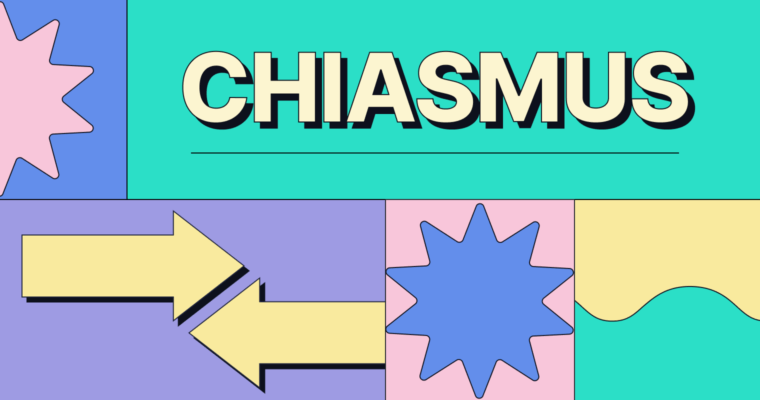
You may be unfamiliar with the term asyndeton, but you’ve likely heard or read hundreds of them. An asyndeton is a rhetorical and literary device in which conjunctions between words or clauses are omitted.
Countless authors, speechwriters, and playwrights have used asyndetons for centuries. We’ll explain how you can use them in your writing and how to pronounce the word, as well as provide famous examples of asyndetons in literature.
What is asyndeton?
Asyndeton is a literary device in which conjunctions—such as and, but, and or—are intentionally omitted to change a sentence’s tone. Asyndeton, pronounced uh-sin-duh-tn, is an Ancient Greek word that means “unconnected.”
Asyndetons serve multiple functions in writing: to speed up a speaker or writer’s rhythm, change the tone of what’s being said, and add emphasis.
The most famous asyndeton example was said by Julius Caesar following a quick battle his army won: “Veni, vidi, vici,” which translates in English to “I came, I saw, I conquered.” The omission of a conjunction makes this quote concise, adding emphasis and underlining the battle’s swiftness.
Because they’re used to add emphasis, asyndetons should be used sparingly in your writing. They may lose their effect if used too often. Your writing will also start looking choppy. Remember that conjunctions allow us to string together complex thoughts, and without them, a reader may become confused.
2 types of asyndeton
The two types of asyndetons are those used between words and phrases and those used between sentences or clauses.
Asyndeton between words and phrases
“Reduce, reuse, recycle” is an asyndeton used between words and phrases. Another example is the popular motivational advice: “Live, laugh, love.” In these examples, asyndetons are used to add emphasis or to make the phrases easier for people to remember.
Asyndeton between sentences and clauses
There are many examples of asyndetons between sentences and clauses in William Shakespeare’s plays. They are typically used to make the lines more poetic by speeding up their rhythm or to underline emotions or themes.
For example, some of Iago’s first lines in act 1, scene 1, of Othello are asyndetons that emphasize his anger, a common theme throughout the play. “Call up her father. Rouse him. Make after him, Poison his delight, Proclaim him in the streets. Incense her kinsmen . . .”
Read the passage with conjunctions in between each clause. Notice how it sounds less angry?
How does asyndeton differ from syndeton?
An asyndeton omits conjunctions between words, phrases, or clauses, while a syndeton uses conjunctions to connect phrases or clauses. Syndeton comes from the Greek words sundeton and sundein, which means “a bond” and “to bind together,” respectively. In other words, a syndeton is the opposite of an asyndeton.
A collection of words or clauses can be an asyndeton or a syndeton, depending on the writer’s objective. Here’s an example.
Reduce, reuse, recycle.
Reduce, reuse, and recycle.
The first example is an asyndeton that’s used to make the phrases more memorable in the hopes that people will produce less waste. The second is more direct and reads like a list. Both are correct, but asyndetons tend to be easier for most people to remember and sound more conversational than a list or a syndeton.
There are also polysyndetons, or the repeated use of conjunctions to connect words or phrases. Polysyndetons slow down the rhythm of a passage to make it more memorable, similar to asyndeton.
Polysyndetons can also be used to stress the importance of words or clauses. For example:
“Neither snow nor rain nor heat nor gloom of night stays these couriers from the swift completion of their appointed rounds.”—US Postal Service creed
5 examples of asyndeton in literature
1 “It was the best of times, it was the worst of times, it was the age of wisdom, it was the age of foolishness, it was the epoch of belief, it was the epoch of incredulity, it was the season of Light, it was the season of Darkness, it was the spring of hope, it was the winter of despair.” —Charles Dickens, A Tale of Two Cities
2 “The air was thick, warm, heavy, sluggish.” —Joseph Conrad, Heart of Darkness
3 “‘O mighty Caesar! Dost thou lie so low? Are all thy conquests, glories, triumphs, spoils shrunk to this little measure? Fare thee well.’” —William Shakespeare, Julius Caesar
4 “Consciousness of place came ebbing back to him slowly over a vast tract of time unlit, unfelt, unlived. ” —James Joyce, Portrait of the Artist as a Young Man
5 “Cold; tempest; wild beasts in the forest. It is a hard life. Their houses are built of logs, dark and smoky within. There will be a crude icon of the virgin behind a guttering candle, the leg of a pig hung up to cure, a string of drying mushrooms. A bed, a stool, a table. Harsh, brief, poor lives.” —Angela Carter, The Werewolf
Asyndeton FAQs
What is asyndeton?
An asyndeton is a literary device in which conjunctions—such as and, but, and or—between words, phrases, or clauses are intentionally omitted while maintaining proper grammar. They are used to add emphasis to what’s being said, underline themes or emotions, and speed up the rhythm.
How does asyndeton work?
An asyndeton works by adding emphasis to what’s being said by removing conjunctions, therefore speeding up the rhythm and making it more memorable to the reader or listener.
What’s the difference between asyndeton and syndeton?
An asyndeton is a group of words or clauses that aren’t connected by a conjunction, whereas a syndeton is a group of words or clauses connected by and, but, or or. A polysyndeton is a collection of words or clauses connected by multiple conjunctions.






